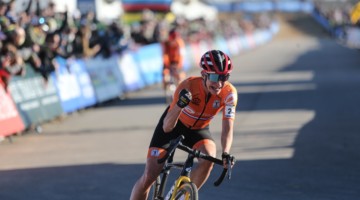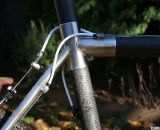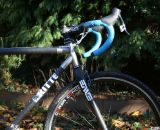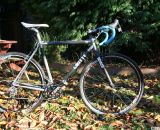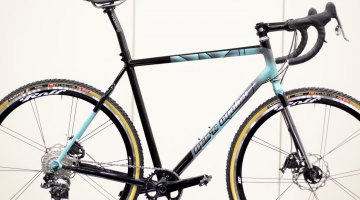We first spied Ritte Van Vlaanderen’s new 2012 mixed-material Steeplechase model at Interbike this year, as the prototype was being prepped for Katheryn Curi Mattis’ CrossVegas race. Ritte’s all-stainless-steel model evolved this year into a striking blend of stainless steel and carbon, and the Steeplechase joins Ritte’s carbon Crossberg in the company’s cyclocross lineup.
A few months after Interbike, we got our hands on that very prototype bike to test out. I’ve been riding the Steeplechase for several weeks now, and am ready for a report. And just as I started wrapping up my review, Ritte unveiled its hydraulic disc brake equipped version of the Steeplechase (courtesy of TRP’s Parabox hyrdaulic brake adaptor, which translates mechanical brake levers into hydraulic lines, Reviewed in Issue 14), and we got a sneak peek of that to share as well, complete with a newly released Enve carbon cyclocross disc fork.
If Curi Mattis’ performance her very first time on the bike was any indication (she went from a fourth-row start to 10th place in a very competitive field in Vegas, her third-ever ’cross race!), then I was in for a treat. Granted, the 2005 road race national champ’s own abilities may have had something to do with that too.I have to admit that, while visually striking, I was skeptical of the need to mix materials. There are great steel and aluminum frames out there, but most manufacturers are choosing carbon for their flagship models.
Spencer Canon, owner of Ritte, explained the frame’s beginnings to me. “First, we started playing around with stainless steel builds, and with using oversized tubing,” says Canon. “Using oversized tubes made it plenty stiff, and we were blown away that we could equal an all-carbon frame on performance and almost on weight, but we could add beauty, custom options, the steel feel and make it locally in the US.
“I got the idea that a stainless steel rear end with carbon top and down tubes would be a brilliant combo. The carbon qualities contribute to the stiffness and handle the road vibrations, but by isolating the rear triangle and making that stainless steel, we focus all of the lively feel of that material there.”Not one to rest on his laurels, Canon quickly started thinking about how to improve the Steeplechase. A tapered head tube (and accompanying fork) was one change he mentioned pursuing when we spoke at Interbike (although I have to say, the standard 1-1/8″ fork and head tube didn’t leave me wanting more stiffness). Incorporating disc brakes soon followed, and led to his current prototype, which is bound for his dealer in Belgium as a display model. And Canon’s already looking for ways to improve that barely-assembled bike. “We’ve been on a mission to explore every innovation we could think of using the stainless steel/carbon combo. The frames we’ve started building are every bit as competitive as an all-carbon frame but with much better feel and liveliness,” says Canon. “When Enve told us about their upcoming carbon disc fork, we saw it as a great excuse to push the frame engineering further and went to work designing a stainless three-piece tapered head tube. We could only get our hands on two of Enve’s disc forks, and this is our first attempt to build a frame around one. We won’t build another one exactly like it since I’m not stoked about the weight, and we want to find a lighter way construct the head tube.”

The combination of stainless steel and carbon provides a unique, wonderful ride. ©Cyclocross Magazine
The construction is, in a way, the opposite of conventional wisdom, where carbon chain and/or seat stays are added to a metal frame. But somehow along the way, Canon discovered a magical ride. There’s the life of steel, but it’s subtle and the ride lacks the “sproinginess” often found in all-steel rigs.
Carbon has come a long way since commonly earning the oft-repeated descriptor “dead” in its early days, but Luddites abound, endlessly proclaiming the virtues of retro-steel. Steel itself has evolved into lighter, better riding tubes, but I’ve yet to find a steel bike that rivals the performance of a top-end carbon rig. Combining the two, and sticking the steel exactly where I’d think you’d want carbon – the head tube, for stiffness, and the seat and chain stays, for compliance – seems irrational to me. But the bike performed with flying colors and left me smiling. I took the bike onto single track, on road rides and into the last couple of races of the season, and it shined. There can be a pleasing vibration when riding along on a steel bike, and it’s oft described as “life” or “soul,” but there’s also the tendency of steel to recoil and launch you when traversing rough terrain. Introduce carbon to lighten the load and reduce what I’m coining as sproinginess, but keep the steel around to provide the carbon tubes with vivacity. I was skeptical too, but I can say the combination lives up to the promise.

Clearance wasn't a factor in my one muddy race (shown here with a 32mm Maxxis Locust), but the chain stays look more SoCal than Portland-friendly. ©Cyclocross Magazine
The Build
The Steeplechase is available as a fully custom frameset; there are no stock builds. Buyers can either spec a build kit through Ritte, or piece it together a la carte themselves. It is worth documenting the setup of the demo bike as it can be difficult to separate “the ride” from “the build” – the second for sure can have a big impact on the first! Did the carbon Enve bars, stem and fork contribute to the excellent handling and buttery smoothness? They certainly didn’t negatively impact the bike’s weight. I’ve always been reluctant to put a carbon cockpit on any bike, let alone a cyclocross rig, due to fear of catastrophic failure after I crack it in one of my inevitable impacts. Perhaps that’s an irrational fear. Needless to say, over the course of testing and racing the bike I did have a couple of tumbles, and everything held up just fine. Maybe I’ll rethink my bias and lighten my own rig a bit with a carbon cockpit.
There was little discernible difference to me when pedaling the Q-Rings, but on long rides and after several days of consecutive training, I did have unusual soreness in my hip flexors. Both the inner and outer chain rings can be positioned to suit a rider, and I haven’t experimented much with dialing the rings in for me yet. Stay tuned, I’ll post a follow-up review of the rings after I’ve had a chance to run them in several positions, and to monitor back-to-back trials against regular rings with a power meter.
Also worth noting is that the demo bike shipped without wheels. That was a good thing, as I could run wheels I’m accustomed to and focus on fewer variables (e.g. the frameset). I mounted my aluminum Corsa Concept wheels with Clement PDX Crusade clincher tires, both for training rides and races. The rest of the tried-and-true build choices, consisting of Force shifters and derailleurs and TRP Euro-X brakes, are also the same as my own current race bike, further allowing me to isolate variables.
The Verdict
The Steeplechase is a winner and left me reconsidering metal’s place on a top-notch cyclocross race rig. If money were no object, this bike would make the list. Unfortunately, price is a primary factor for me, as I’m sure it is for the majority of ’crossers. At about $4k for a frameset, the Steeplechase dwarfs the cost of any complete bike I’ve owned. And for the serious ’crosser with a matching pit bike? Suffice to say that my two bikes, huge array of race gear, bike rack and car don’t match the price tag of two framesets; but I’m pretty deep down in “the 99%.”
The only other potential problem is: good luck finding one to test ride, as there are only a handful yet in existence. But if you can locate one, it’s definitely worth a spin. Be careful though: The ride can be addicting!

Enve 29'er tubeless rims with Stan's Ravens 35mm tires provide a wide contact patch on the Steeplechase Disc bike. Photo courtesy
2012 Ritte Steeplechase Bike Specs:
Frame: Ritte van Vlaanderen Steeplechase with “half mast” integrated seat mast. 1-1/8″ head tube; Short, 429mm chain stays; 73.5 degree seat tube angle / 72.5 head tube angle; 70mm drop; PressFit30 bottom bracket shell
Tubing: 38mm diameter oversized stainless steel main tubes, with a mix of KVA, Paragon and in-house fabricated stainless and Enve carbon tubes. The BB, head tube and lugs are all custom manufactured in house.
Fork: Enve carbon 1 1/8″
Wheels: Enve 45mm carbon clinchers for Curi Mattis [tested with Corsa Concepts aluminum clinchers]
Cranks: Rotor 3D cranks with Q-rings
Brake/Shift Levers: SRAM Force
Brakes: TRP Euro-X
Handlebars: Enve carbon
Pedals: Crank Brothers Eggbeater 3 stainless steel
Chain: KMC
Weight as built: 16.5 lbs (54cm frame)
Made in: USA
More info: http://www.ritteracing.com/
2012 Ritte Steeplechase Test Bike Gallery:
2012 Ritte Steeplechase Disc Bike Specs:
Frame: 2012 Ritte Steeplechase Disc. Stainless steel and Enve carbon. Through-lug seat tube to mast. All stainless tapered head tube; Short, 429mm chainstays; 73.5 degree seat tube angle / 72.5 head tube angle; 70mm drop; PressFit30 bottom bracket shell
Fork: Enve all-carbon 1-1/8 to 1-1/2 inch tapered cyclocross disc fork
Brakes: TRP Parabox mechanical to hydraulic setup (Reviewed in Issue 14)
Wheels: Enve tubeless 29’er rims laced to White Industries hubs
Tires: 700×35 Stan’s Ravens (tubeless)
Build: Shimano Ultegra/CX70 cyclocross-specific group, PRO bars and stem, Prologo saddle, Crankbrother’s Eggbeater pedals
Frame weight: 1850g
Full build: 17.5lbs w/o pedals. According to Spencer Canon, owner of Ritte, “Most of the extra frame weight comes from the beefy head tube. In future versions, we may laser cut the lugs to reduce weight. And the Shimano CX group is pretty heavy –we could easily shave a pound or more off with Red and lighter bars and stem.”
MSRP for either full custom frame/fork, built in SoCal, USA: $4150. Lead time is 10-14 weeks, depending on finish (raw, simple or complex paint)
More info: http://www.ritteracing.com/
2012 Ritte Steeplechase Hydraulic Disc Bike Sneak Peek Gallery:









